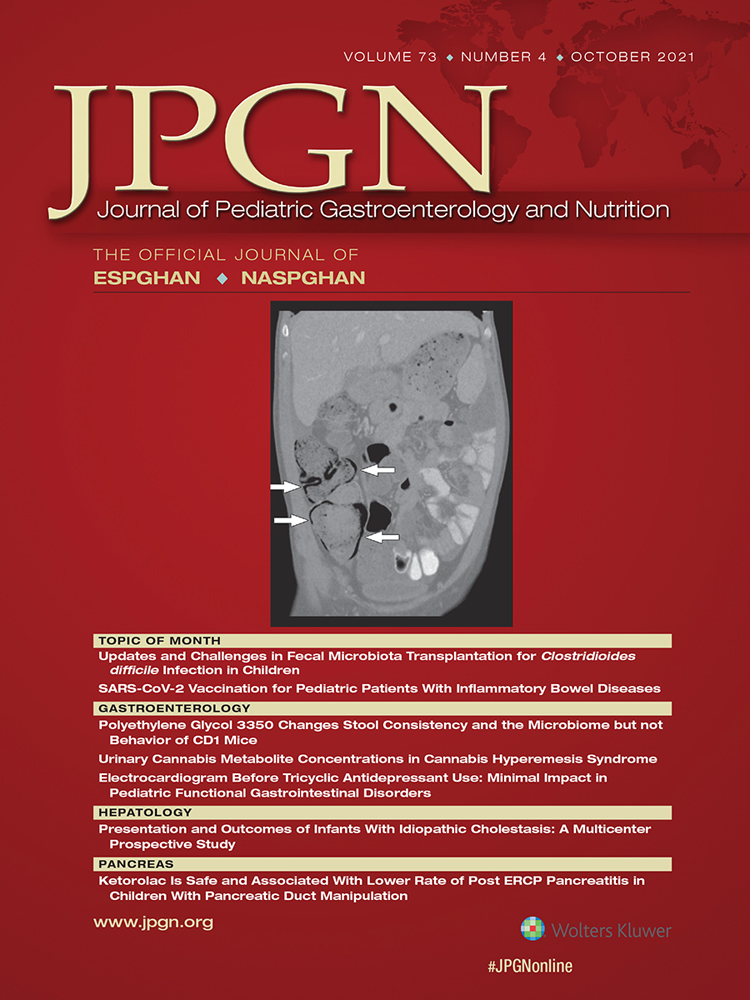Presentation and Outcomes of Infants With Idiopathic Cholestasis
A Multicenter Prospective Study
URL: https://childrennetwork.org/Clinical-Studies ClinicalTrials.gov Identifier: NCT00061828.
This study is funded by the National Institutes of Health/National Institute of Diabetes and Digestive and Kidney Diseases (U01DK103149 to P.H., M.F., and B.S.; U01DK062466 and UL1TR001857 to J.S.; U01DK062470 and UL1TR002378 to N.G.; U01DK062500 and UL1TR001872 to L.B. and P.R.; U01DK084575 and UL1TR002319 to K.M.; U01DK084538 and UL1TR000130 to N.K.; U01DK103135 to V.N.; U01DK084536 and UL1TR001108 to J.M.; U01DK062497 and UL1TR000077 to J.B.; U01DK062481 and UL1TR001878 to K.L.; U01DK062436 and UL1TR000150 to S.T.; U01DK062503 and UL1TR000448 to K.S.; U01DK062452 and UL1TR000448 to Y.T.; U24DK062456 to J.M.; U01DK062453 and UL1TR002535 to R.S.).
P.R. reports consulting for Abbvie, Gilead, Retrophin, Albireo, Mirum, Audentes, Dicerna, Ambys; and grant support from Abbvie, Gilead, Merck, Retrophin, Albireo, Mirum, Arrowhead. K.M.L. reports grant support and consulting for Albireo Pharma and Mirum Pharmaceuticals. J.P.M. reports support from Abbvie, Gillead, Albireo Pharma, Mirum Pharmaceuticals, and CF Foundation. N.K. is on the Advisory Panel for High Tide. For the remaining authors, none is declared.
Supplemental digital content is available for this article. Direct URL citations appear in the printed text, and links to the digital files are provided in the HTML text of this article on the journal's Web site (www.jpgn.org).
ABSTRACT
Objectives:
The aim of the study was to determine the frequency and natural history of infantile idiopathic cholestasis (IC) in a large, prospective, multicenter cohort of infants.
Methods:
We studied 94 cholestatic infants enrolled up to 6 months of age in the NIDDK ChiLDReN (Childhood Liver Disease Research Network) “PROBE” protocol with a final diagnosis of IC; they were followed up to 30 months of age.
Results:
Male sex (66/94; 70%), preterm birth (22/90 with data; 24% born at < 37 weeks’ gestational age), and low birth weight (25/89; 28% born at <2500 g) were frequent, with no significant differences between outcomes. Clinical outcomes included death (n = 1), liver transplant (n = 1), biochemical resolution (total bilirubin [TB] ⩽1 mg/dL and ALT < 35 U/L; n = 51), partial resolution (TB > 1 mg/dL and/or ALT > 35 U/L; n = 7), and exited healthy (resolved disease per study site report but without documented biochemical resolution; n = 34). Biochemical resolution occurred at median of 9 months of age. GGT was <100 U/L at baseline in 34 of 83 participants (41%).
Conclusions:
Frequency of IC and of death or liver transplant was less common in this cohort than in previously published cohorts, likely because of recent discovery and diagnosis of genetic etiologies of severe/persistent cholestasis that previously were labeled as idiopathic. Preterm birth and other factors associated with increased vulnerability in neonates are relatively frequent and may contribute to IC. Overall outcome in IC is excellent. Low/normal GGT was common, possibly indicating a role for variants in genes associated with low-GGT cholestasis—this warrants further study.




